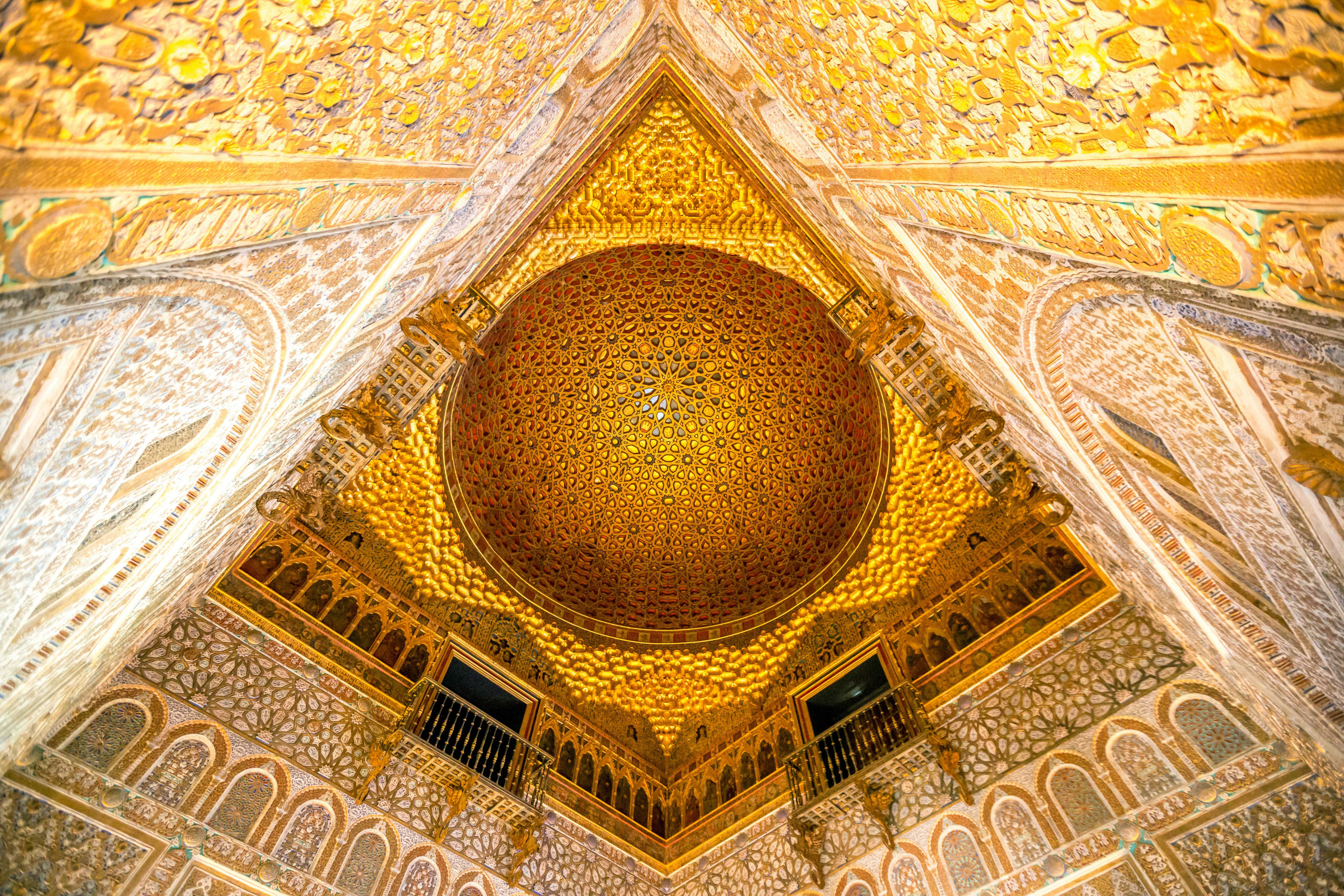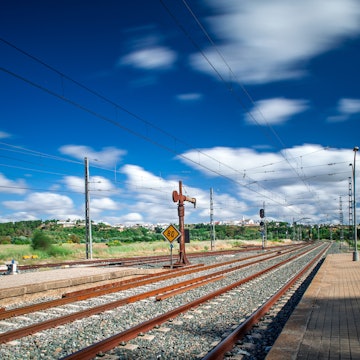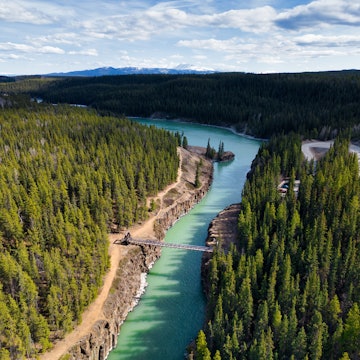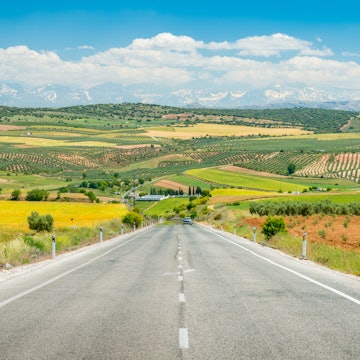

Visitors enjoying a welcome rest in a square in the Barrio de Santa Cruz © Kirk Fisher / Shutterstock
While Seville isn’t an expensive destination compared to a lot of European cities, a visit there can certainly start to add up with the wealth of delights on offer. Luckily, there are lots of ways to ensure travelers on even the tightest of budgets won’t have to miss out – as long as you know how.
You can explore centuries of the city’s history, see a flamenco performance, check out the latest contemporary art or visit the major monuments, all without spending a dime – behold our insider list to the top free things to do in Seville.

Be wowed by Plaza de España
This gargantuan semi-circular brick building with its expansive plaza was designed for the 1929 Expo. With 48 ceramic tiled panels depicting scenes from all of Spain’s provinces, Plaza de España is still as popular with Spanish visitors today. Row a boat around the pretty canal, or let the huge fountain gently splash you on a hot summer’s day. You can also see flamenco dancers perform daily, outside the main entrance.
Tremble in the Inquisition Museum
Once the most feared buildings in Seville, the riverside medieval fortress of Castillo de San Jorge was the seat of the notorious Spanish Inquisition. Today it’s open to the public as a museum that explains the fate of wretched heretics (Jews and Muslims who converted to Catholicism but were suspected of still practicing their faith).
Geek out at the Palacio de los Marqueses de la Algaba
This 15th-century palace hidden behind Calle Feria market boasts an outstanding Gothic-Mudéjar façade. Upstairs, the Mudéjar Art Interpretation Center explains this unique style of architecture, a blend of Christian and Islamic. The small museum displays over 100 Mudéjar relics, and also explains how those intricate geometric patterns on azulejos (glazed ceramic tiles) were created.

Marvel at Seville’s finest palaces
Three of Seville’s most emblematic palaces are free to visitors on Monday afternoons/evenings. The Real Alcázar is a glorious blend of Moorish, Gothic, Mudéjar and Renaissance: its tiling and stucco work rival the Alhambra Palace for exquisite craftsmanship (book free tickets online in advance).
The smaller 16th-century Palacio de la Condesa de Lebrija has superb Roman mosaics, while the Palacio de Las Dueñas was the favorite palace of Spain’s most colorful aristocrat, the late Duquesa de Alba. Collect free tickets on the day. Times are around 4-6pm in winter, and 4-7pm in summer; check each palace’s website for up-to-date details.
Hang out at Gallo Rojo
A cultural and decorative hotchpotch, this afternoon café-bar near the Setas (try the homemade cakes and craft beers) also serves as a hip gallery and cultural center, with jam sessions, live music, comedy and exhibitions.
Feel the duende at La Carbonería
This converted coal factory in Santa Cruz has live flamenco performances every night, as well as poetry readings, film screenings, art exhibitions and other cultural events – and a bar, naturally. Check La Carbonería’s Facebook page for the latest program.
Be dazzled by Iglesia San Luis de Los Franceses
Seville’s most eye-popping baroque church, this circular temple dedicated to King Louis IX of France is a feast of gilt and extravagant carving. Free entry 4-8pm on Sunday.
Escape to Centro Andaluz de Arte Contemporáneo
For an unusual mix of history, art and industrial-religious architecture, plus pretty, peaceful gardens, head over the river to La Cartuja, a 15th-century monastery converted into a ceramic factory (spot the colorful tiles) and now open as the Centro Andaluz de Arte Contemporáneo. Entry is free 7-9pm Tuesday to Friday, and all day Saturday; they also hold jazz concerts and DJ sessions.

Be awed by the Catedral de Sevilla and Giralda
The must-see of Seville is the biggest Gothic cathedral in the world, designed to inspire awe in 15th-century worshippers. The vast carved gold altar is a masterpiece. Other highlights include Columbus’ tomb and the Giralda bell tower. Entry is free at 3.45pm on Thursdays (tickets must be booked online in advance).
Savour the Iglesia Colegial del Divino Salvador
Built on the site of Moorish Seville’s main mosque – you can still see the 9th-century minaret and courtyard where the faithful washed before praying – Iglesia Colegial del Divino Salvador is the city's second-most important church but with no crowds. Look out for the seated Virgin in the former mihrab. Entry is free at 3.45pm on Thursdays (after the cathedral, see above), and is also included with your cathedral ticket.
Visit the Antigua Fábrica de Tabacos
Much of Seville’s phenomenal wealth came from a vastly profitable monopoly on trade with America, including tobacco. When the Fábrica de Tabacos opened in 1758, it employed 6000 people. Women made cigars and cigarettes by hand, including Roma gypsies from Triana – they were the inspiration for Carmen, Bizet’s fiery tragic heroine. Today the huge stone edifice is part of the university. You can join a free tour, usually on weekday mornings – for up-to-date information, see CICUS.

Climb the Torre del Oro
This iconic riverside Moorish tower, built by the Almohad dynasty soon after the Giralda, is now a naval museum. You can check out its model ships and maps for free on Mondays. Don’t miss the fabulous river views from the roof.
Get lost on purpose in Barrio de Santa Cruz
For many visitors to Seville, wandering through the narrow, windy streets of the old Jewish Quarter – and getting happily lost – is a highlight of their stay. If you can, navigate your way to Plaza Alfaro: the romantic curved balcony on the yellow-and-white house on the corner was supposedly the inspiration for the balcony scene in Romeo and Juliet.
Roam through the beautiful surroundings of Parque de María Luisa
Parque de María Luisa is a favored haunt of Sevillano families – children love its pools populated with ducks and fish, gazebo-topped mountain and playgrounds, while architecture fans will gawk at the extravagant Ibero-American Expo 1929 pavilions.
Get arty at Fundación Valentin de Madariaga
In one of the beautiful Expo 1929 pavilions next to Parque de María Luisa, you can see international contemporary art. There are temporary exhibitions as well as the permanent collection, which is themed around nature and the environment and features the likes of Andy Warhol and Joseph Beuys.
Chill out at El Viajero Sedentario
Choose from the cozy interior or pretty patio for a relaxed coffee in this boho cafe on the Alameda de Hércules, and stick around for the free film showings, live music and poetry readings.
Discover the reach of the empire at Archivo de Indias
Built as a merchant’s exchange for trading the abundant materials that poured into Seville from the New World as a result of its colonization, this Unesco-recognised archive next to the cathedral now houses a wealth of documentary evidence about the Spanish Empire. Look out for the maps and ceramic figures.

Find your inner flamenca at Lo Nuestro
Fancy a go at dancing Sevillanas, the dance of Seville's Feria festival? This fun bar on riverside Calle Betis has live music and a welcoming atmosphere. Look out for the tiled entrance plaque.
Browse for unique treasures at El Jueves flea market
Every Thursday morning on Calle Feria, near the Alameda, you can find more than 120 stalls piled high with everything from old military uniforms and religious paintings to postcards, books and magazines, jewelry, Lego figures and flamenco dresses.
Amble along Calle Betis
You’ll get some of the most breathtaking views in Seville as you stroll along this riverside street in Triana. The Torre del Oro, the bullring, and Isabel II Bridge will all come into view as you make your way along the broad pavement next to the river Guadalquivir. Seats carved into the stone wall that runs alongside the river make the perfect stopping points to admire the view and rest your legs. Apart from T de Triana, the bars are mostly tourist traps; instead, head for Calle Pureza or the Mercado de Triana.
You might also like:
How to visit Seville on a budget
The best roof terrace bars for cocktails with a view in Seville
8 best neighborhoods in Seville for flamenco, tapas and Moorish architecture















